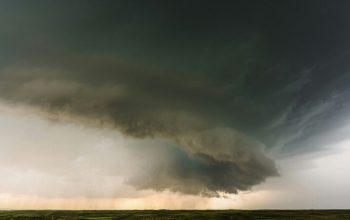At Corn LP in Goldfield, they’re brewing beer from corn, and then refining it into high proof alcohol (aka ethanol) from there – as high as 200 proof. Around 80 million gallons of it per year.
In the process, they produce three primary byproducts. First, there’s a kind of corn meal that’s all that’s left of the corn kernel after the brewing process. Secondly, there’s about 550 tons a day of corn oil; which Plant Manager Andy Miller explained was similar to popcorn oil, but not food grade. And then there’s carbon dioxide (CO2).
The corn meal they can sell for animal feed, usually a dozen or more rail cars of it every day. The corn oil can be refined into lubricants, biofuels, and other products. But the carbon dioxide is currently released into the atmosphere. And although it’s unclear what amount of it is released, if there are 15 rail cars a day worth of corn meal, and 550 tons of corn oil a day, it stands to reason that there’s probably a lot of CO2 released every day, as well.
And that’s why Corn LP is partnering with Summit Carbon Solutions, which they discussed at a junket for the press and local leaders, held at the Goldfield facility. Summit is planning to build a controversial carbon dioxide pipeline designed to carry the potent greenhouse gas from Corn LP and other Iowa ethanol plants, through over 680 miles of pipeline across Iowa (roughly a third of the total length of the pipeline) and then all the way to North Dakota. Where, they say, it will be permanently stored deep underground. Presently, over 240 miles of Iowa easements have been signed, roughly a third of the Iowa section of the planned route.
“With this project, it can really put us on a path to being a carbon negative plant in the future.” noted Corn LP General Manager Chris Boshart (who is also the General Manager / CEO of Gold Eagle Cooperative). Adding that Corn LP is working towards a carbon neutral, or even negative, future, and plans to get there within 10 years.
Which might be essential for the Iowa economy. “The ethanol industry grinds about 40% of all the corn used in the US, supports 44,000 jobs and adds about $52 billion to the US GDP every year,” said Summit Carbon Solutions Chief Commercial Officer Jim Pirolli. “So this is a very important industry to continue to support to help decarbonize in the future.”
“The opportunity in the future is to take the carbon out of the air and put it back in the ground,” said Boshart.
Once injected into the sandstone-shale strata of North Dakota, roughly a mile deep, the carbon dioxide would, according to Pirolli, “eventually become part of the rock”. But according to a study by the Earth Sciences Division of the Lawrence Berkeley National Laboratory, it’s not that simple.
“The CO2 mineral-trapping capacity after 100,000 years reaches about 90 kg per cubic meter of the medium. The CO2 trapping capacity depends on primary mineral composition,” reads one part of the study summary. The mineral composition of the ground needs to meet specific requirements to effectively sequester carbon dioxide. The ground should be “bedded sandstone-shale” rich in two primary minerals that can trap carbon dioxide, dawsonite and ankerite. Dawsonite is a form of crystallized sodium aluminum carbonate hydroxide which is not typically mined. Ankerite is a close cousin of dolemite, except it is more iron heavy and less magnesium heavy than dolemite, and it is mined for iron and magnesium.
It is not clear whether the deep rock strata sequestration would even hold the carbon, or what might happen over time. “Dawsonite reaction kinetics is not well understood,” the Earth Sciences study summary stated, and also that “leaching of chemical constituents from the interior of the shale causes slightly increased porosity.”
And because ankerite is mined for metals, and North Dakota is one of the U.S. states which is most heavily fracked for shale oil (found in the same type of bedded sandstone-shale structures where Summit Carbon plans to sequester carbon dioxide from ethanol production) it is unclear that future industrial activity won’t disturb the sequestered CO2. Aside from any natural events.
There have also been other concerns that have been raised by locals at multiple public meetings. One centers on whether the pipeline will damage drainage tile. Another on the question of whether the buried networks of drainage tubing common across Iowa farm fields could factor into a leak. Yet another, that has been quite controversial, has been the issue of whether pipeline builders can use eminent domain to take land from landowners who refuse to sign easements. And whether those who do sign easements, will find those easements abused, or otherwise come to regret it.
Another concern to locals is the risk of leaks, ruptures, and explosions. Such as the explosion of a carbon dioxide pipeline that occurred in Mississippi on February 22nd, of 2020. Which reportedly sent 45 people to local hospitals, and caused the evacuation of more than 300 people from their homes.
According to the U.S. Department of Transportation’s (DOT) Failure Investigation Report, the pipeline “ruptured in proximity to the community of Satartia, Mississippi. The rupture followed heavy rains that resulted in a landslide, creating excessive axial strain on a pipeline weld.”
“When CO2 in a super-critical phase (which is common for CO2 pipelines) releases into open air, it naturally vaporizes into a heavier than air gas and dissipates,” the report states. Except that didn’t happen in Satartia. In that explosion, the report states, “atmospheric conditions and unique topographical features of the accident site significantly delayed dissipation of the heavier-than-air vapor cloud.”
Concentrated CO2 gas is heavier than air, which (as occurred in Satartia) can cause it to hang close to the ground. Where it can suffocate people, pets, and wild animals, and even cause engines to stop due to a lack of oxygen. All in a very short period of time.
Which is what DeEmmeris Burns, a lumber worker, said happened to him and two other men who authorities rescued from a stalled car on the roadside, after the rupture. “My cousin said, ‘My car cut out!’,” Burns told the audience of a Sierra Club hosted webinar. “Immediately after that, we cut out. And we stayed under from 7 until 11.” The Sierra Club opposes the Summit Carbon Solutions pipeline and two other proposed Iowa pipelines.
Carbon Dioxide, according to the DOT report, “is classified as an asphyxiant, displacing the oxygen in air.” It notes that inhalation of “extreme” concentrations of CO2 “can lead to death by asphyxiation”. That “higher” concentrations can cause “rapid breathing, confusion, increased cardiac output, elevated blood pressure, and increased arrhythmias,” And that symptoms of exposure to “lower” concentrations of CO2 “may include headache and drowsiness.”
But burns and the other men in the car that stalled due to the Satartia burst report suffering memory loss and other traumas as a result of their exposure, and filed a lawsuit in Texas, the home of the pipeline operator, Denbury Resources, in September of 2021. However, Denbury Resources and 17 related companies, filed for bankruptcy in July of 2020.
Another question is whether it is even necessary to build this, or if ethanol fueled vehicles aren’t actually the wave of the future, but instead a soon to be discarded thing of the past. According to reporting earlier this month by Bloomberg, the U.S. has reached the tipping point of electric car sales. After which electric cars are expected to become as ubiquitous as smart phones, within a decade.
“We have to have multiple pathways to decarbonizing transportation,” Pirolli said, addressing that report.
“Locally, here, some of the issues are hard to understand,” Boshart said, responding to land use and safety questions as well. “But at a national or global level, there’s no doubt about it: our country is pursuing a low-carbon future.”
And that may be the crux of the matter. Yes, a carbon pipeline presents serious risks. And yes, there are still as yet unanswered questions, and concerns. But there are also very serious risks to taking no action. Whatever the future holds, clearly efforts are being made in the here and now to deal with our current environmental impact. And it is up to the people of Iowa to decide which risks are greatest. Is it the risk of a possible local pipeline disaster? Drainage issues? Eminent domain? Or is it the risk of severe drought? Stronger and more frequent storms? Economic losses? And the many other dangers of climate change that affect Iowa? And is there some way to safely do the pipeline, to protect the present day economy, and the future climate? Those are the questions before Iowans right now.







